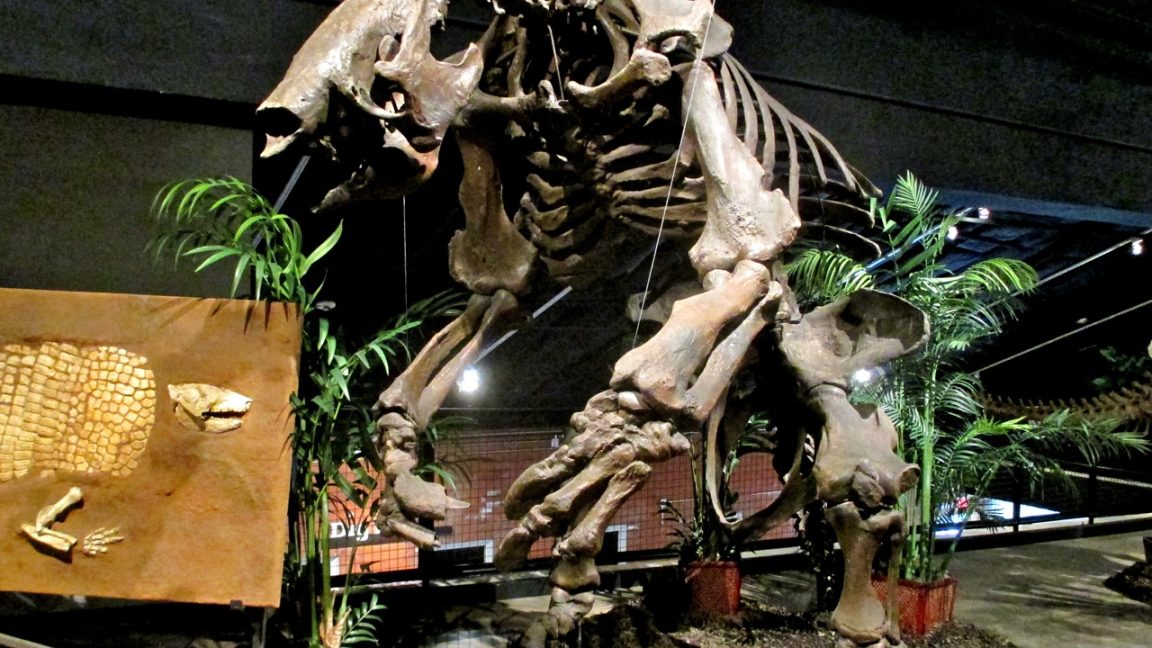Science
Study Links Human Hunters to Extinction of South American Megafauna

A recent study indicates that human hunting may have played a significant role in the extinction of Pleistocene megafauna in South America. Archaeologists, led by Luciano Prates from the National University of La Plata, analyzed animal bones from various archaeological sites to understand the dietary habits of ancient hunters. Their findings reveal that extinct species, such as giant sloths and giant armadillos, were likely key components of the diet of early humans in the region.
The research focused on 20 archaeological sites in modern-day Argentina, Chile, and Uruguay, dating back over 11,600 years. At these locations, the team meticulously counted bones with clear signs of butchering, such as cut marks. The results showed that at 15 of the 20 sites, the majority of butchered bones belonged to now-extinct megafauna. Notably, at 13 of these sites, more than 80 percent of the bones identified were from extinct species.
In central Chile, the most sought-after prey was identified as Notiomastodon platensis, an extinct relative of modern elephants, while in regions like Patagonia and the Pampas grasslands, ancient hunters favored giant sloths. The researchers suggest that hunting these large animals was advantageous due to the higher caloric returns compared to smaller prey.
As the last Ice Age came to a close, many megafauna species began to disappear. Mammoths, saber-toothed tigers, and giant armadillos faced extinction, while others, such as horses, vanished from the Americas until their reintroduction by European colonists. This period has sparked debate among scientists regarding the extent to which human activity contributed to these extinctions. While climate change is often cited as a primary factor, the latest findings suggest that human hunting practices may have accelerated the decline of these giant animals.
Initial observations indicated that the megafauna did not start to decline until approximately 13,000 years ago, long after humans had settled in the region. The apparent lack of evidence linking human activity to the extinction of megafauna led some researchers to exonerate early hunters. Nevertheless, the introduction of new hunting tools, such as the fishtail projectile point around the same time megafauna began to die out, raises questions about human influence on these extinctions.
Prates and his team argue that the timeline of human and megafauna cohabitation in South America was relatively short, lasting less than 3,000 years. They contend that the evidence may not have been preserved due to mixing of Pleistocene layers with Holocene remains, leading to a potential misrepresentation of the hunting patterns of ancient peoples. Their findings emphasize that humans were, in fact, significant players in the ecosystem during this transitional period.
According to the “prey choice model,” researchers can analyze the hunting decisions made by early humans based on the caloric yield of various animals. This model illustrates that megafauna, including giant sloths and extinct horses, provided substantial nutritional returns, making them prime targets for hunters. Interestingly, modern megafauna such as guanaco and vicuña offer less caloric value, suggesting that contemporary hunters may have shifted their focus to these smaller species only after the decline of more favorable prey.
The implications of this study are profound, as they suggest a direct link between human hunting practices and the extinction of some of the most iconic creatures of the Pleistocene epoch. As Pleistocene hunters skillfully navigated their environment, they made choices that ultimately contributed to the disappearance of these magnificent species. The findings were published in the journal Science Advances, shedding light on the complex relationship between humans and megafauna in prehistoric South America.
-

 Politics4 weeks ago
Politics4 weeks agoSecwepemc First Nation Seeks Aboriginal Title Over Kamloops Area
-

 World5 months ago
World5 months agoScientists Unearth Ancient Antarctic Ice to Unlock Climate Secrets
-

 Entertainment5 months ago
Entertainment5 months agoTrump and McCormick to Announce $70 Billion Energy Investments
-

 Science5 months ago
Science5 months agoFour Astronauts Return to Earth After International Space Station Mission
-

 Lifestyle5 months ago
Lifestyle5 months agoTransLink Launches Food Truck Program to Boost Revenue in Vancouver
-

 Technology3 months ago
Technology3 months agoApple Notes Enhances Functionality with Markdown Support in macOS 26
-

 Lifestyle3 months ago
Lifestyle3 months agoManitoba’s Burger Champion Shines Again Amid Dining Innovations
-

 Top Stories2 months ago
Top Stories2 months agoUrgent Update: Fatal Crash on Highway 99 Claims Life of Pitt Meadows Man
-

 Politics4 months ago
Politics4 months agoUkrainian Tennis Star Elina Svitolina Faces Death Threats Online
-

 Sports5 months ago
Sports5 months agoSearch Underway for Missing Hunter Amid Hokkaido Bear Emergency
-

 Politics5 months ago
Politics5 months agoCarney Engages First Nations Leaders at Development Law Summit
-

 Technology5 months ago
Technology5 months agoFrosthaven Launches Early Access on July 31, 2025





















